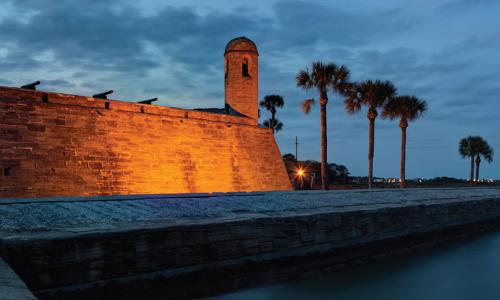With its black and white candy-stripe marking, Cape Hatteras Lighthouse on the Outer Banks of North Carolina is one of the country’s most famous landmarks. More than 200 feet in height, it was the tallest brick building in the world when it was completed in 1870 by the U.S. Army Corps of Engineers.
Designed to warn vessels up to 22 miles away of the dangers of nearby Diamond Shoals, in recent years the lighthouse itself was in danger of being lost to the sea.
This profile is excerpted from the 2014 report, National Landmarks at Risk: How Rising Seas, Floods, and Wildfires Are Threatening the United States' Most Cherished Historic Sites."
Coastal erosion and sea level rise prompted the National Park Service (NPS) to take action to save the Cape Hatteras Lighthouse. In 1999, after more than a decade of study and debate, the NPS moved the lighthouse inland. In recent years, sea level has been rising in the Outer Banks two to three times faster than the global average. And since 1970, the number of hurricanes in the North Atlantic that reached Categories 4 and 5 in strength has roughly doubled.
As long ago as 1988, a National Research Council study identified increasing rates of sea level rise as one of the factors imperiling the lighthouse. It was 1,500 feet from the ocean when it was built, but by the end of the twentieth century the distance was only 120 feet. The NPS was faced with several options: It could decide not to take any action and let the sea claim the lighthouse, try to protect the structure with seawalls and groins (walls built perpendicular to the shore), or find a way to move it to a safer place. In the end, after much public discussion, the agency decided to shift the whole building.
The lighthouse’s original brick and granite foundation was built on a bed of yellow pine timbers that rested on the compacted sand lying just below the island’s water table. The construction engineers of the 1860s did not have pile drivers that could penetrate the hard sand, so they devised this elegant solution as an alternative to supporting the tower on deep vertical pilings. As long as the timbers were under fresh water, they would not rot. But erosion of the surrounding sand and the intrusion of saltwater would threaten the foundation and therefore the entire building.
So the Cape Hatteras Lighthouse, weighing over 4,800 tons, was lifted from its foundation using a complex system of jacks and support beams, and slowly and painstakingly moved nearly 3,000 feet to the southwest along an improvised steel track. The keepers’ quarters and several other historic buildings were also moved.
The situation at Cape Hatteras is not unique. Along its full length, the Outer Banks system of barrier islands is vulnerable to higher seas and strong storms. Barrier islands are constantly changing; they naturally migrate toward the mainland as storms and waves wash sand over them, replenishing the area behind them. But faster sea level rise accelerates the process, and the increased pace of coastal development has brought more people and infrastructure into harm’s way.
More than 3 million visitors come to the Outer Banks each year to visit its landmarks and attractions, such as the Cape Hatteras Lighthouse, the Wright Brothers National Memorial, and the “Lost Colony,” the first English attempt to settle what is now the United States, on nearby Roanoke Island. Many families return summer after summer, and tourism is a vital economic engine for the eastern part of North Carolina. Many efforts to reduce vulnerability to coastal erosion and storms have been undertaken along the coast, including nourishment of beaches and the rebuilding of dunes, but storms regularly erase these measures. Highway 12, the main route along the Outer Banks, and the Bonner Bridge across the Oregon Inlet are part of the vital but vulnerable infrastructure. Hurricane Irene caused two breaches of Highway 12 in 2011; Hurricane Sandy dumped three to four feet of sand on the roadway in 2012; and in 2013 a nor’easter again buried the highway.
The Cape Hatteras Lighthouse continues to attract more than 3 million visitors every year. But as climate-change impacts continue to become manifest, the hard choices that were made in deciding how to respond to an imminent threat to the lighthouse’s future will have to be made again and again for other cherished national heritage sites.




